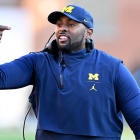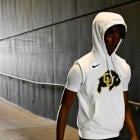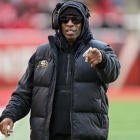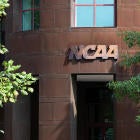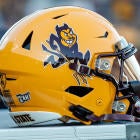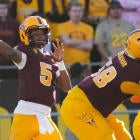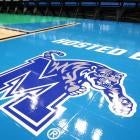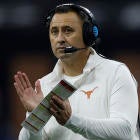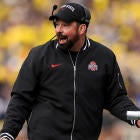More college football: Jon Solomon | Dennis Dodd | Jeremy Fowler | Latest news
Georgia wide receiver Chris Conley's question last January midway through a three-hour discussion about the new NCAA model seemed to catch the adults off guard. "Where do the student-athletes fit into this governance structure?" Conley asked at the NCAA convention before about 800 attendees.
Wake Forest president Nathan Hatch, the chair of the Division I Board of Directors, responded awkwardly, "That's not something we've wrestled with."
They have now. But what does it mean that for the first time college athletes' voices are going to be counted by the NCAA? Hailed as a historic vote Thursday to change the Division I model, the NCAA and its schools placed a relatively small amount of power into the hands of players. How they utilize this new role will ultimately answer questions about whether voting rights represent real progress for athletes' voices to be heard or constitute window dressing.
The new model, assuming it’s not vetoed by the membership over the next two months, gives athletes 18.8 percent of the votes on all autonomy legislation proposed by the Power 5 conferences. For shared governance, athletes get 3.1 percent of the vote. The chair of the Student-Athlete Advisory Committee (SAAC) will become one of the 24 members of the Division I Board of Directors.
“SAAC is only 25 years old, and 25 years later student-athletes are actually going to have a vote,” said SAAC chair Kendall Spencer, a recent track and field athlete at New Mexico. “That’s huge.”
National College Players Association executive director Ramogi Huma, who is pushing for player unions, said NCAA voting rights for athletes is more symbolic than substantive.
“College sports have proven that athletes can’t trust the NCAA to do the right thing, and less than 20 percent (of the vote totals) isn’t good enough,” Huma said. “Despite a step in the right direction, there are many, many ways to keep these players powerless.”
As the NCAA and its members face lawsuits and Congressional scrutiny, the conferences are preparing to tackle some issues that directly impact athletes, such as cost of attendance stipends, medical insurance and time demands on their sport. Voting rights for players carry new questions:
• Which players will get NCAA votes and how will those representatives be decided?
• Could players form a voting bloc on certain issues, or are their views too divergent and the percentage of their vote too small to make a real impact?
• Will players with votes be willing, if necessary, to vote against their university and question the information coming from the NCAA, conferences and schools?
• How will complex issues get presented to thousands of Division I athletes prior to votes so there’s an informed consensus of their opinions?
Given their time demands and other interests, many college athletes understandably don’t actively follow NCAA issues that can directly impact them. Conley, who has been a committee member on SAAC and passionately
“Not everybody knows who to ask the right questions to,” Conley said. "A lot of guys will ask their teammates in the locker room and their teammates don’t know. So it’s like the blind leading the blind. We need to break down some of the barriers that people have when it comes to going to speak to administrators or going to speak to coaches or people who have worked extensively with the NCAA.”
SAAC chair opposes unions
Behind the scenes, Spencer is busily preparing for athletes’ voices to count. As chair of SAAC, he would have a vote on the Division I board under the new model.
Spencer wants to restructure SAAC so more players' voices can be heard from the bottom up. He wants to make sure current athletes, not former ones, have the 15 athlete votes from the Power 5 conferences. And he’s trying to change a perception that SAAC is essentially an NCAA-controlled advisory committee that muzzles real dialogue.
Like the paid administrators who vote on NCAA issues, college athletes come to the table with different backgrounds, biases and experiences. Spencer, for example, is a graduate student spending the summer at the University of Massachusetts pursuing his interest in neuroscience. He’s also a hip-hop dancer who has performed with a professional dance company.
Spencer was initially on the NCAA’s witness list for the Ed O’Bannon trial about athletes being paid off their names, images and likenesses but wasn’t called. Spencer said he is noncommittal about whether college players should be allowed to make money off their own name, preferring to wait until he gets an accurate picture of how college athletes feel.
To Spencer, the idea of player unions is a “scary thought.” He worries athletes run the risk of universities cutting a sport in which players have unionized.
“One direction the conversation might need to shift to is does this provide for the well-being of all student-athletes?” Spencer said. “It’s not just football and basketball student-athletes vs. volleyball players and swimmers. It’s also the football players who are on scholarship and not on scholarship. I think one thing people have to realize is not everybody needs to be paid. There’s a lot of misinformation out there.”
That can cut both ways. Since athletes have been cut of the decision-making process for so long, they’re presumably going to rely upon a lot of information coming from their campuses, such as how and why they allocate funds and make certain decisions. That could result in votes by athletes that might seem illogical on the surface.
For instance, in 2012 SAAC opposed the NCAA dropping its ban of multiyear athletic scholarships, arguing that one-year scholarships are a good incentive for players to stay engaged at school and on a team. The NCAA barely passed the rule that now gives schools the option to offer multiyear scholarships.
At a Senate committee hearing in July, NCAA president Mark Emmert testified that SAAC’s position “was counterintuitive at many levels. I was surprised.”
Replied Sen. Claire McCaskill (D-Mo.): “I would like to talk to those students because I think they probably felt pressure from their coaches. I have a hard time believing any student would think it’s in their best interest to get a one-year scholarship instead of a four-year scholarship.”
Huma said he doesn’t fault the players on SAAC for trying to have a voice. But he questions the mechanism of SAAC, which he says is meant to be ineffective.
“No matter how hard a player on SAAC tries, it’s like crossing the ocean on a bicycle,” Huma said. “I don’t think that has changed. Some members of SAAC publicly discussed how they were muzzled and didn’t have a voice, and they've done so privately to me as well.”
At the NCAA convention in January, then-SAAC member Melissa Minton was quoted in The Chronicle of Higher Education as saying the NCAA wants SAAC to have a voice, “but they put a muzzle on us.” Minton, a former soccer player at Louisiana-Lafayette, shared with the Chronicle of Higher Education an NCAA document that she said requires any position of advocacy taken by SAAC must be approved first by the NCAA’s president or its executive committee.
The NCAA policy said the group’s chair is the “speaking agent” of the committee and requires all SAAC members to make clear their individual views aren’t representative of the committee or the NCAA. The NCAA said in January that committee chairs speaking for SAAC is consistent across all NCAA committees.
Minton, who currently serves on the NCAA Championship team Works advisory board and whose SAAC term ended in July, said this week her comments were overheard during a conversation and taken out of context. “I believe that (student-athletes’) voice is heard and valued when speaking with people within the NCAA,” Minton wrote in a message through Twitter.
Reporter Brad Wolverton said he interviewed Minton twice for the Chronicle of Higher Education article and later communicated via text to confirm Minton’s position.
Spencer said the NCAA has no control over SAAC’s positions.
“They might kind of assist us in the way we word things in terms of political correctness or things that might catch people’s eyes, just like any larger organization that helps assist you writing statements,” Spencer said. “But if we were to say as an advisory committee, let’s put out a statement about this, this and this, we can absolutely do that. We've never had a liaison at the NCAA level say, no, we can’t talk about that.”
Small voting bloc
The truth is, the athletes’ voting numbers may be so small that they don’t really matter when it comes to NCAA governance.
In the initial proposal for the new Division I model, the Power 5 conferences were going to need 54 of the 80 votes (65 votes for school representatives, 15 for athletes) to pass their own legislation. The threshold got lowered to 48 of the 80 votes.
Spencer acknowledged that the voting numbers are “very small” for athletes.
“The way we feel about it is it’s a start,” he said. “For the longest time, student-athletes didn’t even have a tangible vote so to come off the bat and request 50 percent of the voting power would probably be unreasonable of a first-time trial. Let’s focus on getting our voice out with this current structure and make sure student-athletes are equipped with the knowledge and background to submit that vote. If we do that, I’m sure we’ll see those voting numbers increase in the future.”
Spencer envisions SAAC’s campus representatives communicating more with their administrators and funneling that dialogue up to the conference and then national SAAC levels. He said it’s possible more campus dialogue with athletes could even change the votes by administrators.
“So instead of student-athletes having this small percentage of a vote, you now have the support of people who are all going in the same direction,” Spencer said.
Huma said some SAAC members have told him they don’t feel empowered by the NCAA and don’t want to “rock the boat” because they want to work in college sports. That raises a question: If necessary, will athletes be willing and knowledgable enough to question information presented to them on campus?
“I don’t think it’s so much as questioning as it is getting a background and an understanding of the current system,” Spencer said. “Anytime you look at issues like this, we could say we as student-athletes feel you shouldn’t be allocating the funds this way, and then you get the info and you might feel differently. At this point, we don’t know. I think the discussion will be healthy.”
Conferences are expected to individually decide how they will choose which athletes vote on autonomy issues. Spencer expressed concern about discussion he has heard that former athletes, not current ones, will vote on autonomy issues.
“That’s crazy, right?” said Spencer, a former athlete himself who’s still on SAAC. “When I saw that, I said wait, aren’t we moving in a different direction?”
Big 12 commissioner Bob Bowlsby said the presumption is the autonomy votes by athletes will come from current or recently graduated players. “It doesn’t have to be people with remaining years of competition,” he said. “They could still be involved in SAAC or someone nominated by an institution who would be a particularly good representative.”
Pac-12 Commissioner Larry Scott said he has heard no discussion about former players getting votes in the new model. “In our conference, I wouldn’t see any need or benefit for former student-athletes voting,” Scott said. "I see this step as an integration and therefore a more impactful role for student-athletes in that they'll be at the table with athletic directors and senior women's administrators and faculty reps and presidents."
Spencer said he will write a letter in the coming weeks to the conferences advising them to use current athletes for their autonomy votes and to consider SAAC committee members as those representatives. Spencer also plans to contact Huma to discuss the causes he’s championing.
For years, Spencer said, SAAC has been unable to get a meeting with Huma. Huma said he can’t recall ever rejecting a conversation with a SAAC member.
“We’re always open to talk,” Huma said. “But I think we would be careful around the idea that the NCAA would try to co-opt the conversation by trying to prop up SAAC.”
It took lawsuits, unionization efforts and public shame for athletes to acquire NCAA voting rights. Now what are they going to do with those votes?
“At the end of the day, you can’t argue this isn’t an improvement,” Spencer said. “It might be a small improvement, but it’s a start.”












